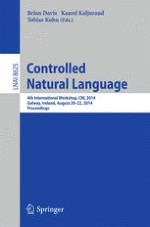2014 | Book
Controlled Natural Language
4th International Workshop, CNL 2014, Galway, Ireland, August 20-22, 2014. Proceedings
Editors: Brian Davis, Kaarel Kaljurand, Tobias Kuhn
Publisher: Springer International Publishing
Book Series : Lecture Notes in Computer Science
